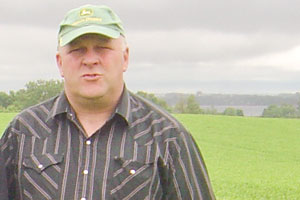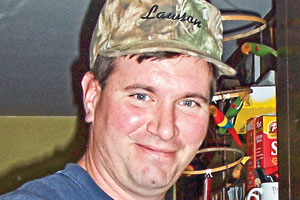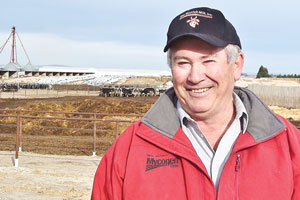On that topic, John Anderson, a reader from central Pennsylvania, shares his experience from last season: “With the continued financial stress we have been incurring, I made the decision this past year to use a ‘cheaper’ inoculant.
I have always used an inoculant, as I believe they are a necessity to improve forage quality and animal performance.
Though I have read many articles over the years stressing the importance of choosing an inoculant with proven research, I’ve often wondered it they weren’t all about the same.
So, I thought I’d save myself $0.15 per ton. After all, the company said their product had the same bugs as other inoculants. BIG mistake. My forage quality is noticeably (visually) worse and the cows are not milking well either. The $0.15 per ton is costing me dollars a day. Next year I will be going back to my old product.”
 Jeff Handschke
Jeff Handschke
Sugar Creek Dairy • New London, Wisconsin
We are hoping to start chopping corn silage in mid-September – we’ll almost have to, otherwise we will run out of time.
However, we will only have about 20 percent of our corn ready at that time due to the weather-delayed planting earlier this spring and loss due to mid-June flooding.
My crop scout and a large-herd specialist from Croplan Genetics assist me in shredding and drying whole-plant corn samples.
We pull stalks from the fields, run them through a garden-type brush chopper and then dry them in a koster moisture tester.
We will begin harvesting around 74 percent maximum moisture. We prefer 70 to 73 percent moisture; at this level we never seem to lose any milk production without first allowing the corn to ferment.
We do use an inoculant to help preserve feed and speed fermentation, but no longer use an L. buchneri product, due to the cost. Our nutritionist feels we do a good enough job packing without it.
 Rodney Elliott
Rodney Elliott
Drumgoon Dairy • Lake Norden, South Dakota
The thing that really drives harvest for us here is moisture. It can dry up as early as the third or fourth week of August, but it’s usually the first ten days of September.
We’re looking for the average field to be about 31 percent dry matter (DM) to get organized to go. We have to start about 32 and finish about 36 to 37 to end up with an average crop at about 33 to 34 percent DM.
We usually do use an inoculant and look at it as an insurance policy so we have a better- than-average chance of making good silage.
This year, with the price silage is going to be and the need for it, it’s going to be more important than ever.
We use a dry inoculant, a contractor-type one, that harvesters can use to cut over 500 tons on the fill of a tank.
That is important because down time costs them money and me time, and we can’t afford to lose either one.
 Scott Reiland
Scott Reiland
Reiland Farms • LeRoy, Minnesota
We anticipate harvesting our BMR corn silage crop in mid-September, a bit later than normal due to the weather this spring.
When it is time to chop, we take a whole-plant moisture test to ensure it’s at the ideal moisture level for harvest.
Because BMR has a brown tint, it can look like it’s drying down before it’s ready for harvest, so testing is an important step.
To ensure a good harvest, we always inspect our equipment — sharpen the chopper blades and replace the processor rolls if necessary.
But length of cut is also very important, especially with BMR varieties. Our chop length for BMR is set at 1 inch and that’s worked really well for us.
Our nutritionist recommends using an inoculant. It comes as a dry powder; we add water and then apply it with the chopper. We will start feeding the new crop in December.
 Keith Dawydko
Keith Dawydko
Anchor Farms, Inc. • Clarence, New York
In most years by the last week in August or the first week in September we will be checking the ear for a milk line. This year I think harvest season will be later due to our late spring.
When the milk line is close we will cut some sample stalks and chop them up in a wood chipper. After chipping we take a sample and run a dry matter test on it.
Depending on the weather, heat and moisture, we try to determine a start time.
We do use an inoculant for the same reason we bought a chopper with a kernel processor. You only have one chance to make your corn silage for the next year, so we try to do everything we can to make that silage the best we can.
When you break down that cost over the entire year, I don’t think you can afford not to use it.
 Ray Robinson
Ray Robinson
Moo Mountain Milk and East Ridge Milk • Burley, Idaho
Normally we start harvesting our BMR corn silage around September 15, but because of the wet spring we didn’t get our planting done until late June.
But when it is time for harvest, we’ll run a bit of corn through the chopper, dry it and check the moisture level. Our goal is to come in at 68 percent whole-plant moisture.
BMR corn silage is softer and breaks up easier, so it’s important to use a longer chop length than you would for conventional corn. This past year we went up to an inch-and-a-half because the silage was so wet. It fed better and worked really well for us.
We apply an inoculant in liquid form that goes on over the chopper. We have always used an inoculant because it helps us get the pH down quicker, resulting in better silage quality. FG









